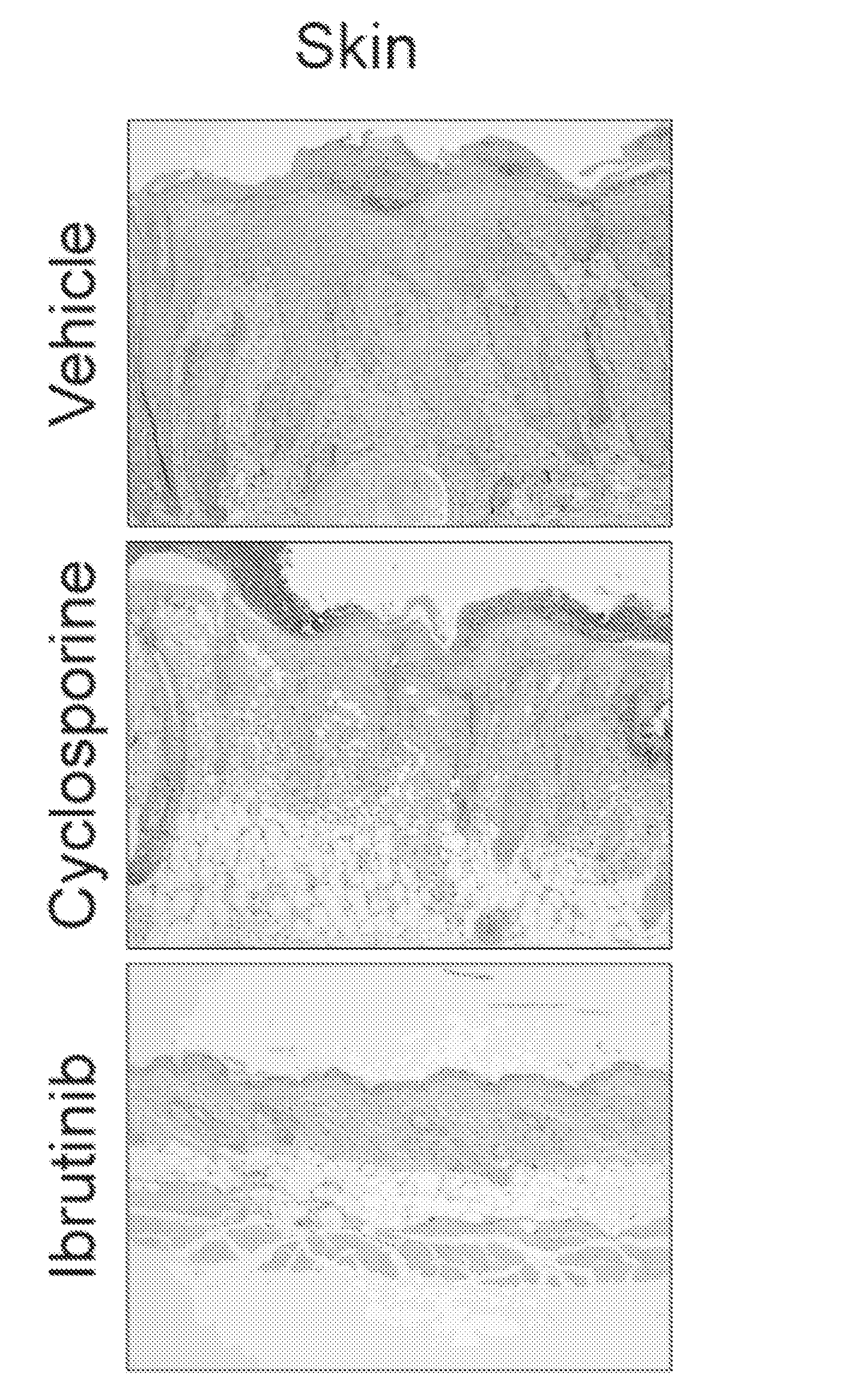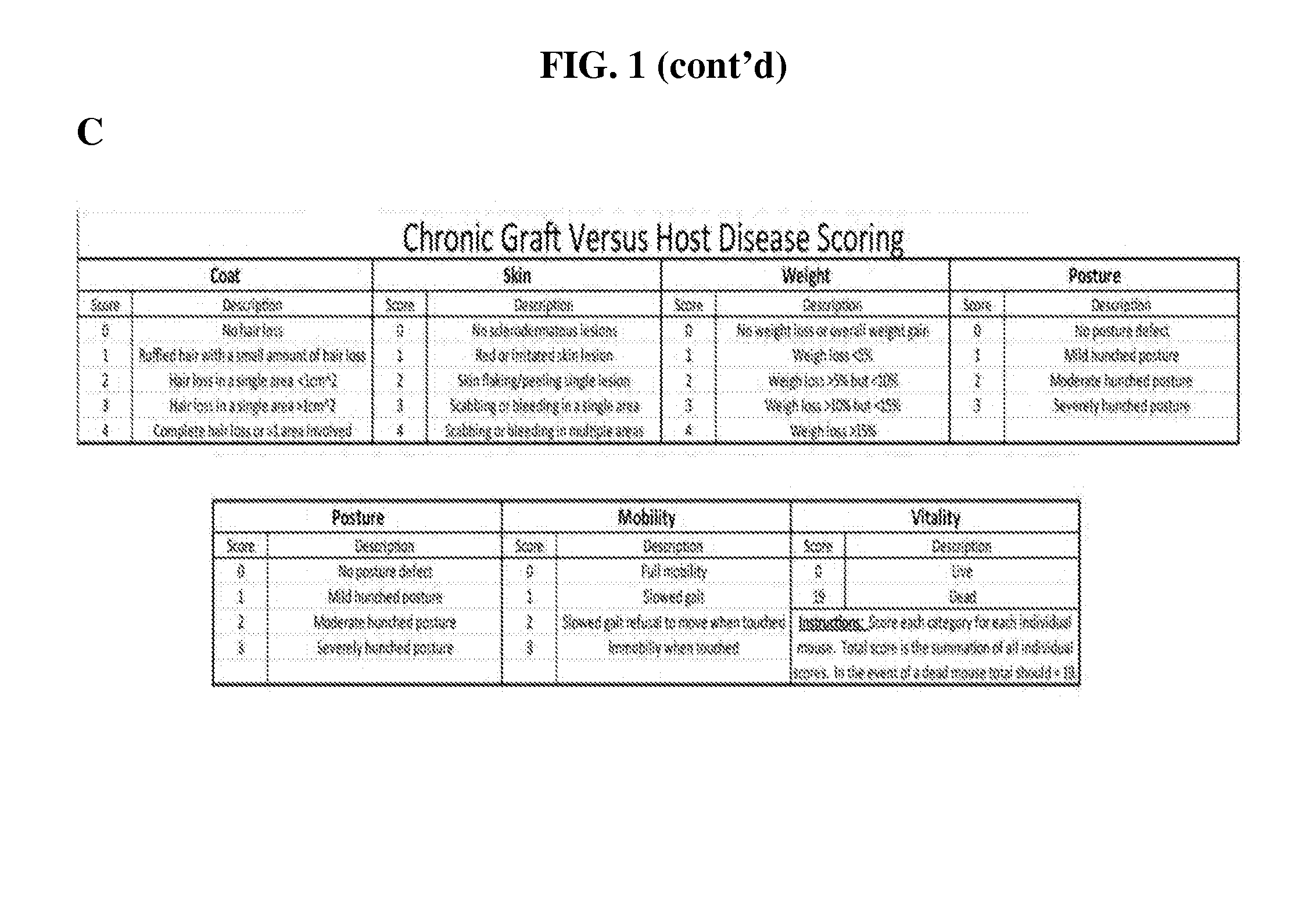Methods of treating and preventing graft versus host disease
a technology of host disease and graft, which is applied in the field of treating and preventing graft versus host disease, can solve the problems of further morbidity and damage to the organ system, and achieve the effects of preventing or reducing gvhd, reducing the severity of gvhd, and high risk cll
- Summary
- Abstract
- Description
- Claims
- Application Information
AI Technical Summary
Benefits of technology
Problems solved by technology
Method used
Image
Examples
example 1
Immune Reconstitution and the Development of cGVHD
[0293]The influence of lymphocyte reconstitution at days 30 and 100 following allogeneic SCT on subsequent development of cGVHD was evaluated using of an extensive immune reconstitution flow cytometric “immunome” assay, which allowed for monitoring of changes in cell activation markers, memory T cell status, Treg subsets, NK cell subsets and Th1 vs Th2 cell subsets. Patients who developed cGVHD had a larger increase in CD4+ T cells and a smaller increase in CD8+ T cells compared with patients who did not develop cGVHD over time, suggesting a selective expansion of CD4+ T cells. Further, a significant decrease in NK cells and concomitant increase in percentages of activated B cells was noted. An increase in CD4+ cells is associated with an inflammatory phenotype, and a Th2-skewed proinflammatory response may contribute to B cell activation. The presence of a Th2-skewed phenotype was supported by the presence of increased CD4+ / CD193+ c...
example 2
Ibrutinib in a Murine Model of cGVHD
[0294]An established in vivo allo-bone marrow transplant (BMT) model system was used to preclinically test ibrutinib as a therapy for cGVHD. The LP / J→C57BL / 6 model is a murine model of sclerodermatous cGVHD which develops dermal lesions characterized by hair loss, redness, flaking, scabbing, hunched posture, and thickened skin. In this murine model, external symptoms become apparent between days 20 and 25 and peak between days 37 and 47 post hematopoietic stem cell transplantation (HSCT).
[0295]C57BL / 6 mice received lethal X-ray irradiation (850cGy) followed by allo-BMT derived from MHC-matched LP / J mice. A small number of mature spleen cells were included in the transplant to seed the development of cGVHD. The studies demonstrated that approximately 1 / 3 of mice survived to day 25 post transplant and at that time began to develop classic external signs of cGVHD including scleroderma, hair loss, hunched posture, weight loss, and dermal fibrosis. The...
example 3
Ibrutinib Inhibition of CD4 T-Cell and B-Cell Activation in Cells from Patients with cGVHD
[0310]CD4+ T-Cell Activation in Cells from cGVHD Patients Inhibited by Ibrutinib
[0311]Primary CD4+ T-cells were isolated from patients with active cGVHD, pretreated with 1 μM ibrutinib (or DMSO), and stimulated using anti-CD3 for 6 hours. Quantitation of the activated T-cell percentage for each patient showed a significant decrease in the population of CD69+ CD4+ T-cells (FIG. 7A) in cells pretreated with ibrutinib as compared to DMSO.
[0312]B-Cell Activation in Cells from cGVHD Patients Inhibited by Ibrutinib
[0313]B-cells isolated from patients with cGVHD were pretreated with 1 μM ibrutinib and stimulated with anti-IgM for 45 minutes. Analysis of B-cell receptor pathway activation using phospho-specific antibodies for pERK1 / 2, pBTK, and pPLCγ2 revealed that ibrutinib was effective in inhibiting the B-cell receptor pathway (FIG. 7B). These data confirmed that ibrutinib curtailed immune receptor ...
PUM
| Property | Measurement | Unit |
|---|---|---|
| Frequency | aaaaa | aaaaa |
| Frequency | aaaaa | aaaaa |
| Mass flow rate | aaaaa | aaaaa |
Abstract
Description
Claims
Application Information
 Login to View More
Login to View More - R&D
- Intellectual Property
- Life Sciences
- Materials
- Tech Scout
- Unparalleled Data Quality
- Higher Quality Content
- 60% Fewer Hallucinations
Browse by: Latest US Patents, China's latest patents, Technical Efficacy Thesaurus, Application Domain, Technology Topic, Popular Technical Reports.
© 2025 PatSnap. All rights reserved.Legal|Privacy policy|Modern Slavery Act Transparency Statement|Sitemap|About US| Contact US: help@patsnap.com



